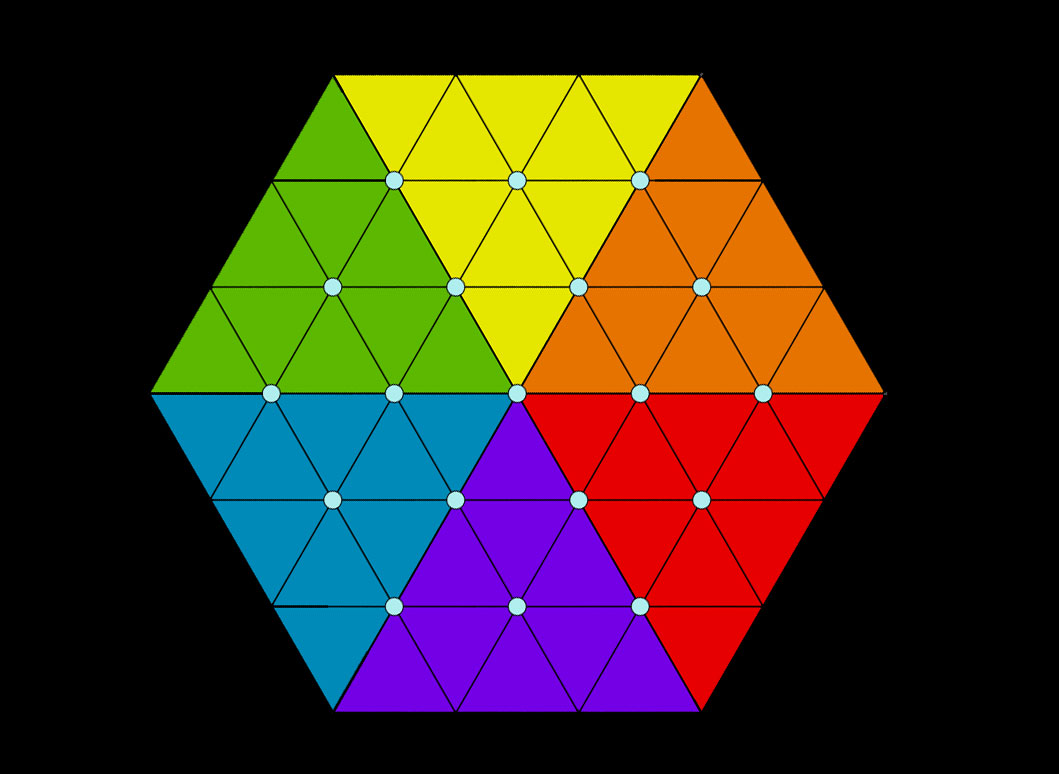Trinagon first entered it's creators (my) imagination in 1988 or thereabouts (me being a teenager then)
At that time turbo pascal was the programming language we learned in school. There where none of those cool tools that make programming a breeze nowadays, but the base game could already run with VGA graphics (Anyone remember - 16 Colors at 640x480px).
There were no animations programmed whatsoever. Instead the colors where interchanged. The game could be played using the keyboard. It really was more of a programming excercise, but i thought the concept was pretty cool and well.... New.
The design was exactly like the base layout for the editor, 6 Rainbow colors around the hexagon grid with 9 triangles each.
I played the game about 10 times.
Then i decided, it was to easy to solve, and therefore sort of ... boring :/
No further designs were tried or variations, and the idea discarded as too simple.
Unfortunately the code (even though i do not have a turbo pascal compiler anymore) was not preserved throughout the years.
..
Many many years later, in 2015 seeing some puzzle games around, and maybe playing 'monument valley' and other 3dimensional puzzles, the old idea came back in a slightly different shape :
The same puzzle logic of adjacent interchangeable triangles, but wrapped around symetrical bodies (platonic ones especially).
A very short search led to a wonderful program & learning tool : Geogebra, which allows for 3 dimensional vector calculations and graphical representations and is very easy to learn and apply. (The above picture was made using Geogebra)
With geogebra the basic 3D shapes could be understood and visualized, but it also became clear that the game idea would not necessarily make sense, and really the idea did not seem sooo great, as to make the effort of learning how to program it in nowadays programming environment.
A short dabble into the unity editor made it clear that programming has become a very different kind of animal since 1988. Somehow much easier, with bigger concepts and structures in play that come out of the box, yet at the same time with a rather steep learning curve (unless you wanted to write Yet Another Monster Game).
This year (2018) finally there seemed to be enough time and interest to learn something new. Unity and c#, and some blender modelling started a process that did turn out to be much more interesting than anticipated.
The intention was really just the learning exercise, and the knowledge that, looking at the stupidity of some games out there, even an easy game can be an improvement. (Since then i have learned that it's not soooo easy after all).
Not even 2 months later the game was already playable, but just like its original still lacked something, until ..
the animations in 3D revealed a whole new world of possibilities !
When triangles were allowed to have two distinguishable sides (faces), and then also a direction, things got interesting indeed.
Suddenly a rather simple game evolved into a complex and diverse creation of many possibilities. Who would have thought of that !
To discover this world was and is a pleasure and it's a decent amount of work to develop the details. The process is still going on. The mathematics (group theory) on that example will be a pleasure to see, as will be the creation of many puzzles, and solving them and getting a better idea of the principles.
The actual idea from 2015, wrapping a 2D game over 3D bodies, was under construction throughout 2019 and has been published in Nov. 2019.
